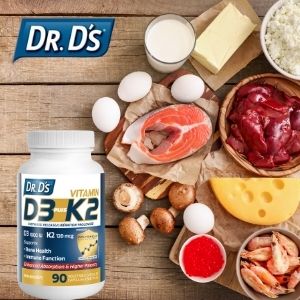
All About Vitamin D
Share
There seems to be some confusion surrounding vitamin D. Some common questions asked in practice include the difference between vitamin D2 and D3, what exactly the health benefits are and how much you need to be taking. Keep reading and you will have those questions answered! One thing most people seem to be aware of, luckily, is that Vitamin D is a vital contributor to overall health.
Vitamin D is famous for its critical role in healthy bone development and maintenance, but it is also an immune supporter and inflammation reducer. Vitamin D comes in two forms; vitamin D2(ergocalciferol) and vitamin D3 (cholecalciferol). Humans obtain vitamin D3 from a few animal-sourced foods and sunlight. Vitamin D2 comes mainly from plant-based sources.
It is hard to naturally obtain adequate amounts of vitamin D from food alone, and considering our long winters and lifestyle factors which keep us from being outdoors, supplementation of vitamin D is highly recommended.
What is the difference between Vitamin D3 and Vitamin D2 supplements? You may have noticed that vitamin D supplements come in either form. While there has been some debate over which is better to consume as a supplement, research supports that D3 tends to raise blood levels of the vitamin more and remains in the bloodstream longer than D2. Plus, it seems to be preferred among experts as it is the form that is already found naturally within the body.
Wonder which foods naturally contain vitamin D? Here is a quick list-
- Fish:
- Cod liver oil
- Salmon
- Tuna
- Swordfish
- Sardines
- Mackerel
- Herring
- Egg yolk
- Some mushrooms (D2)
- Beef liver
As you can see, few foods are naturally rich in vitamin D, which is why a lot of food is fortified with the vitamin (like orange juice, milk, and cereals).
Without enough vitamin D in the body, calcium and phosphorus levels in the blood start to decrease, which leads to calcium being leeched out of the bones to help maintain levels within the blood. This can lead to rickets in children and osteoporosis (fragile bones) in adults.
Some common signs and symptoms of Vitamin D deficiency include:
🔹 Fatigue
🔹 Slow wound healing
🔹 Low bone mineral density
🔹 Frequent or recurrent infections or illness
🔹 Chronic bone and/or muscle pain
🔹 Depressed mood
🔹 Hair loss
🔹 Dry eye
Always remember that too much of a good thing can also be harmful. For example, too much vitamin D can lead to calcium deposits throughout the body, which can lead to calcification of the kidney and other organs including the heart, lungs and blood vessels.
Click here to find out much vitamin D you require and what amount would be considered dangerous for you!
It is important to ensure you are getting adequate Vitamin D in your diet, as the benefits are plenty, including:
🔹 Strengthens Bones and Muscles
🔹 Supports Immune System
🔹 Reduces Inflammation
🔹 Supports Oral Health
🔹 Supports a Healthy Pregnancy
🔹 Can help battle depression (particularly, seasonal depression)
🔹 May reduce the risk of developing Multiple Sclerosis
Looking for a vitamin D3 supplement? Read all about why you should pay attention to Dr. D’s Vitamin D3 plus K2 powered by the REVOLUTIONARY Polyshield TechologyTM on our blog here ... including the impressive results of the product’s very own pilot study!
Sources:
NHS UK. Vitamin D. 2020.
Harvard School of Public Health. The Nutrition Source: Vitamin D. 2021.
Spirtzler, F. Healthline. 8 Signs and Symptoms of Vitamin D Deficiency. 2018.